Learn how to write the best cover letter with expert tips, examples, and templates. Follow step-by-step advice to highlight your skills and land interviews.

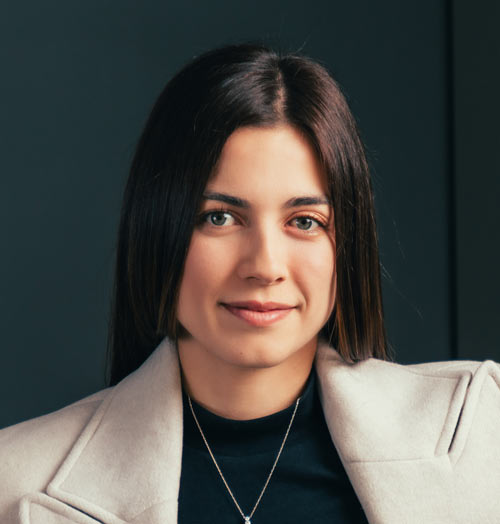
.webp)
The best cover letters are personalized, concise, and focused on describing your most relevant skills and experiences. Start by addressing the hiring manager by name and highlighting how your qualifications align with the job. Use specific examples to demonstrate your strengths and make a connection with the company’s needs. Keep your tone professional yet approachable, ensuring the letter is free from errors and easy to read.
Nobody’s jumping for joy at the thought of writing a cover letter, right? (If you are, please tell me your secrets.) But here’s the thing: if you put in the effort just once and create a killer cover letter, you’ll have a solid foundation for every job application that comes your way. Whether you’ve got tons of experience or none at all, a well-written cover letter can help you rise above all the basic “To Whom It May Concern” submissions (seriously, let’s leave that in the past).
The tricky part for most of us is figuring out what to say that’s not already on your resume. It’s not about repeating your job history, it’s about giving a sneak peek of who you are and why you’re so great. And good news — you don’t need to be a professional writer to pull it off. Just a little direction, and you’ll be fine.
In this guide, we’ll cover:
- How to Write the Best Cover Letter of Your Life.
- 5 Examples of Great Cover Letters.
- 17 of the Best Cover Letter Templates, from Rezi, MS Word, Canva, and Google Docs.
If you want your cover letter done for you, we’ve got an AI Cover Letter Builder for that. And if you need more help, check out these guides:
- Formatting Advice for Your Cover Letter
- Tips for Making Your Internship Cover Letter
- How to Make a Cover Letter with No Experience
- When Are Cover Letters Absolutely Necessary?
- 13 Cover Letter Mistakes to Avoid
What Makes the Best Cover Letters Truly the Best
A cover letter is more than a formality — it’s your chance to show who you are beyond your resume. The best cover letters emphasize your passion for the role and the company while showcasing specific skills and experiences that make you the ideal candidate.
Don’t just repeat your resume in paragraph form. Use this space to share personal stories or examples that reflect why you’re perfect for the job. Think of it like venting to your friends about your dream job and why it’s meant for you, but this time, you’re persuading the hiring manager to see it too.
How to Write a Great Cover Letter
In short: use a simple font like Arial or Verdana at 10–12 pt, and highlight your name at the top in 20–24 pt. Keep it to one page, with single or 1.15 spacing and one-inch margins. Start with a strong, tailored opening that shows enthusiasm and mentions the company’s mission. In the main body, showcase your skills with examples, and express genuine interest in the company. Close confidently, thanking the hiring manager, then proofread for errors before sending.
1. Format your cover letter
Before you start writing, make sure your cover letter looks as polished as it sounds.
- Pick a simple, easy-to-read font like Arial, Calibri, or Verdana.
- Use 10–12 pt for the body text and spotlight your name at the top in a bold 20–24 pt font.
- Keep it to one page — between 300 and 400 words is the sweet spot.
- Stick to single or 1.15 spacing with one-inch margins all around.
2. Get the greeting right
Try to find the hiring manager’s name — LinkedIn, the company website, or even the job posting might have it. If you can’t track it down, “Dear Hiring Manager” is the next best thing.
Whatever you do, don’t start with the generic “To Whom It May Concern” or “Dear Sir/Madam.”
For more on this, check out How to Address a Cover Letter.
3. Start with a strong opening
Your first sentence should grab the hiring manager’s attention and show enthusiasm. Mention the job title and where you found the listing, then connect it to why this role excites you.
Show them you’ve done your homework — reference the company’s mission, culture, or a recent project that stood out to you. A personal touch makes your application more memorable.
Examples:
- “I’m excited to apply for the [Job Title] position at [Company Name] because [specific reason related to the company or role].”
- “When I saw the posting for [Job Title], I knew I had to apply — this role perfectly aligns with my expertise in [Key Skill] and passion for [Industry/Field].”
If you want to learn more, explore Starting Your Cover Letter Right (With Examples.
4. Write a customized main body
Your cover letter should show you understand what the company needs and how you can help. Use the job description as a guide to highlight the skills and qualities they’re looking for.
- Instead of listing skills, back them up with examples. Describe how you’ve made an impact in previous roles, and whenever possible, use numbers to add credibility.
- “I saw that you’re looking for someone with strong analytical skills and a proactive mindset. At XYZ Company, I optimized internal reporting systems, cutting data retrieval time by 30% and improving team productivity.”
- “I developed an inventory tracking system that reduced stock shortages by 20%, ensuring smoother operations and cost savings.”
- Show that you’re genuinely interested in the company. Mention their values, a recent initiative, or their mission to demonstrate why you’d love to be part of their team.
- “I admire [Company Name]’s commitment to innovation, and I’m eager to contribute my expertise in [Relevant Skill] to help drive that forward.”
- If you’re switching industries, relocating, or don’t have direct experience, explain how your skills transfer and why you’re making the change.
- “While my background is in [Previous Industry], my experience in [Skill] directly applies to this role. I’m eager to bring my expertise in [Related Skill] to [Company Name] and grow within this field.”
5. End with a confident closing
This is your opportunity to leave a lasting impression, so emphasize your excitement about the role and the value you bring. Highlight how your skills align with the company’s needs and how you can contribute to their goals.
- “I’m excited about the opportunity to bring my skills in [Key Skill] to [Company Name] and contribute to [Specific Company Goal or Value].”
Thank the hiring manager for their time and consideration and make it clear you’re interested in continuing the conversation.
- “Thank you for considering my application. I look forward to discussing how I can add value to your team.”
Close with a professional sign-off, like “Best regards” or “Sincerely,” followed by your full name.
For a more detailed guide, read about Ending a Cover Letter (With Examples).
6. Proofread before you send
Look for typos, grammar mistakes, and any awkward phrasing. Keep it professional and clear — ditch the jargon, long paragraphs, and vague examples.
Have a friend or someone in the field take a look to catch anything you might’ve missed. Once you’ve got a solid draft, you can easily tweak it for each job and company you apply to.
Best Cover Letter Examples
Here’s a curated list of top cover letter examples. Feel free to customize these templates to reflect your individual experiences and qualifications.
If none of these quite fit, check out our collection of 52 Skillfully Crafted Cover Letter Examples.
Standard cover letter example
This cover letter effectively highlights the candidate’s relevant work experience and familiarity with key tools. It connects their organizational and multitasking skills to the job’s needs. The genuine excitement about the position and company also shines through.
Student cover letter example
This entry-level cover letter effectively showcases the candidate’s transferable skills, even without direct experience. It highlights how their education and part-time jobs have prepared them for the role, while also conveying eagerness to learn and grow.
Career change cover letter example
This cover letter works because it’s customized for the specific role and company. It showcases transferable skills from sales while reinforcing the applicant’s architectural background with a degree and recent course.
Here’s a career change cover letter for someone transitioning from sales to architecture:
Alternative cover letter example
This cover letter template has been a go-to on Reddit for 10 years, helping people land jobs. It’s simple, effective, and gets straight to the point — showing hiring managers what they need and how you’re the right fit. While it’s worked for many, keep in mind that the table format might not be ATS-friendly.
Check out this popular cover letter sample from Reddit user u/iB3ar:
The refined alternative cover letter example
If you liked the original format but don’t want to risk using a table, this version is a solid alternative. Instead, you’re directly addressing what the employer wants and showing how your experience proves you can deliver. Straight to the point — why they can trust you to do the job.
Here’s an alternative to the alternative cover letter:
Best Cover Letter Templates
The best cover letter templates strike a balance between personality and professionalism — just a step above a plain Word document. You can add a touch of style without edging into territory that might confuse the ATS, so stick to simple fonts, one-column layouts, and no unnecessary graphics.
Let’s start with the classic Rezi design for a cover letter:
Rezi cover letter template
The Rezi cover letter template is simple and effective. Your name stands out in bold, your contact details are easy to find, and the paragraphs are concise yet detailed. This example lets the nurse expand on their experience, highlighting how they’d contribute to the company — and why the company would benefit from hiring them.
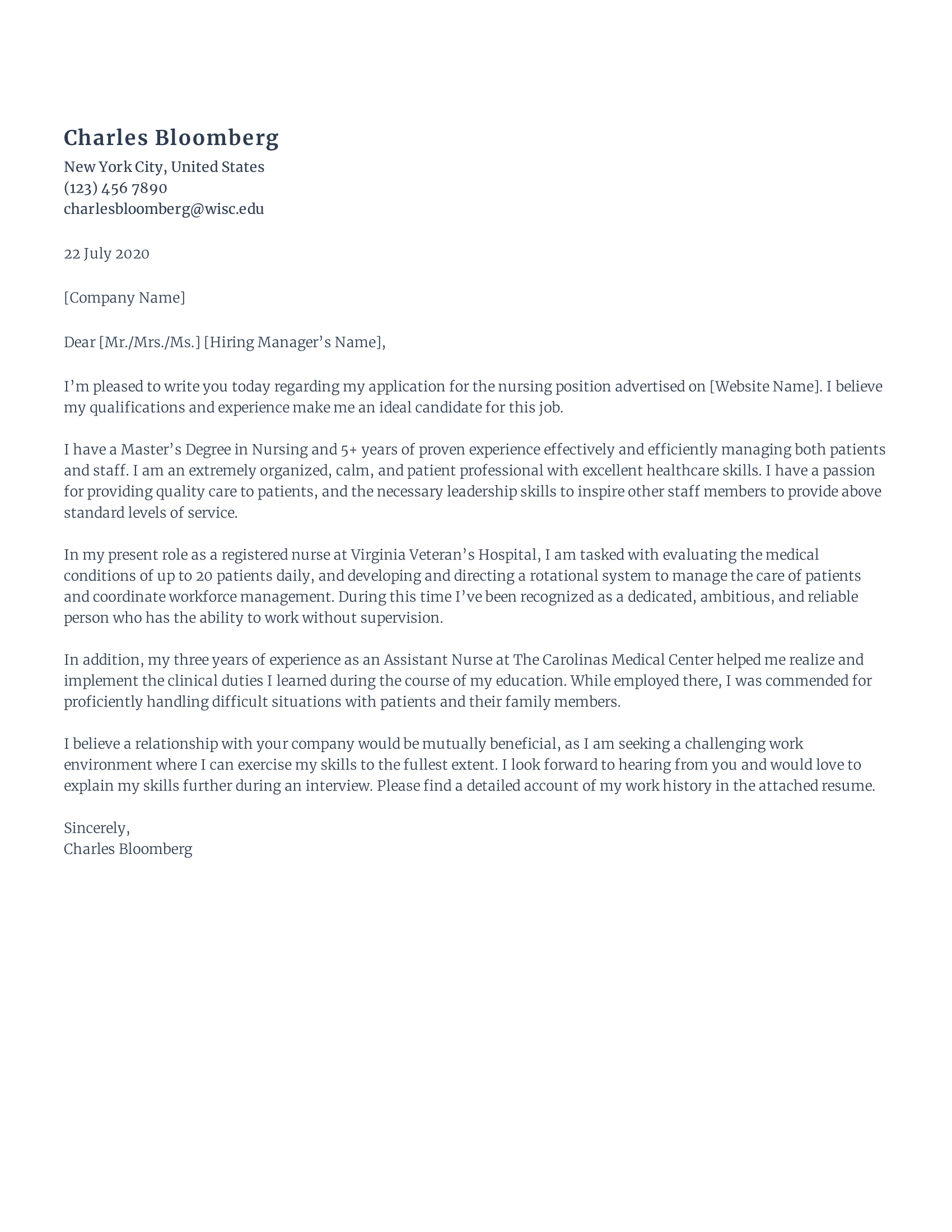
For more options, check out our full collection of 180+ Free Cover Letter Templates & Samples.
Next, we’ll look at some of the best Microsoft Word cover letter templates:
Sales cover letter template
This simple template is ATS-friendly and easy to read. Consider trimming the opening paragraph and skipping the hiring manager’s details on the right. The bold, capitalized name at the top conveys confidence, while the blue font adds flair.
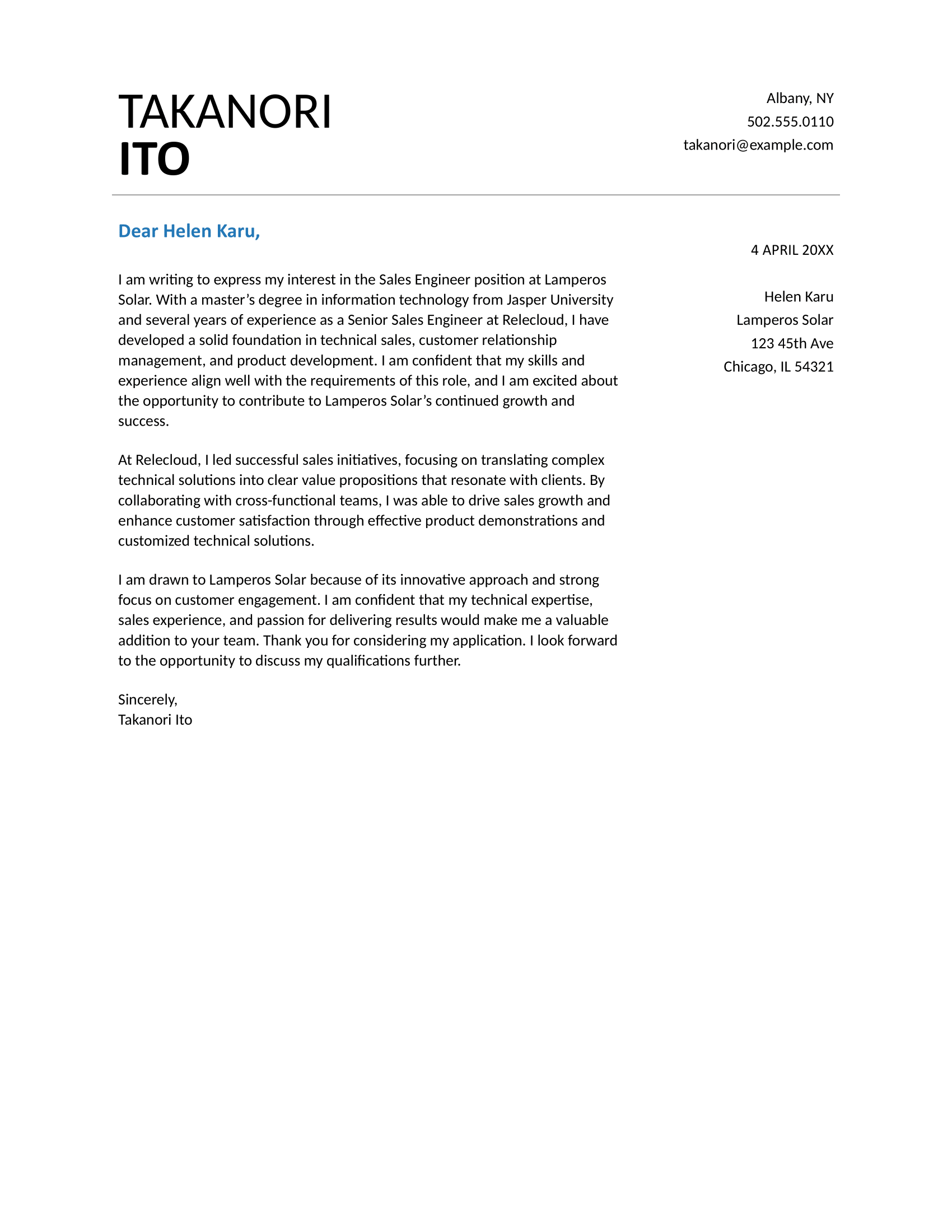
Blue cover letter template
The blue gives this cover letter some personality, without compromising the sleek, professional design. For better space efficiency, place the date right above “Dear Recipient’s Name.”
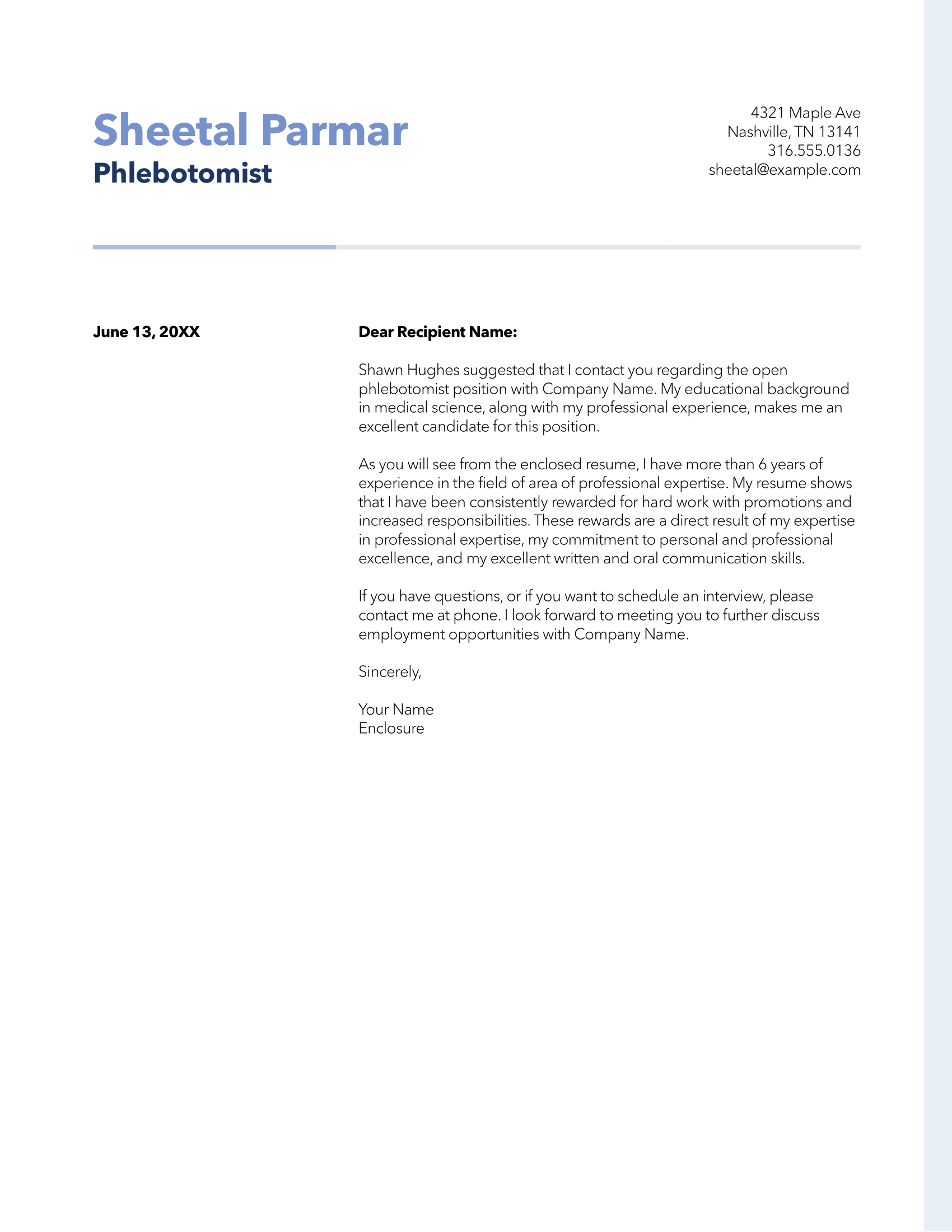
ATS cover letter template
Designed for clarity and ease of reading, this template is structured for ATS compatibility. The sectioned header ensures recruiters can instantly find your contact details, making it a strong choice across industries.
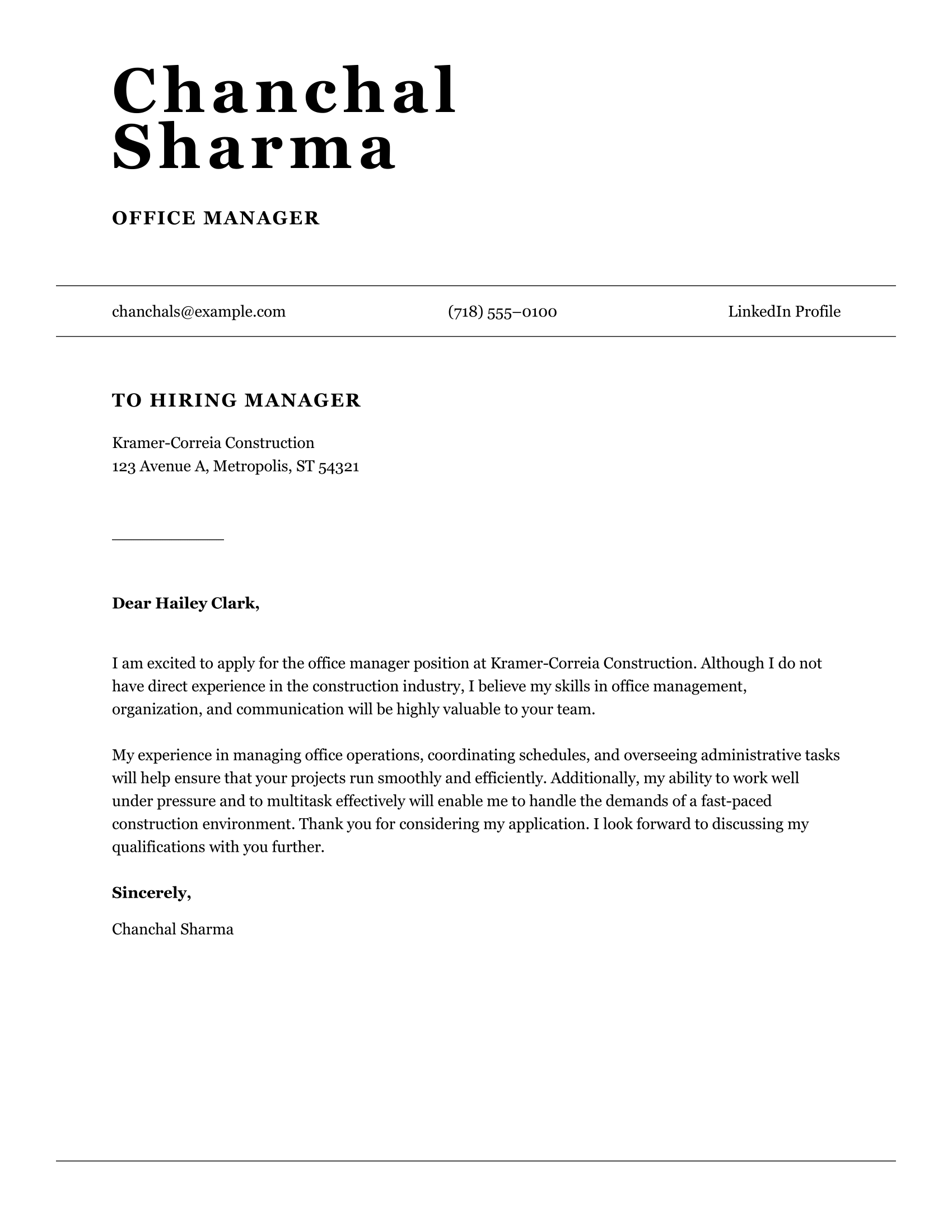
Classic cover letter template
Professional with a modern edge, this template features green accents and subtle border lines. To maximize space, remove the hiring manager’s address or align it with your contact info.
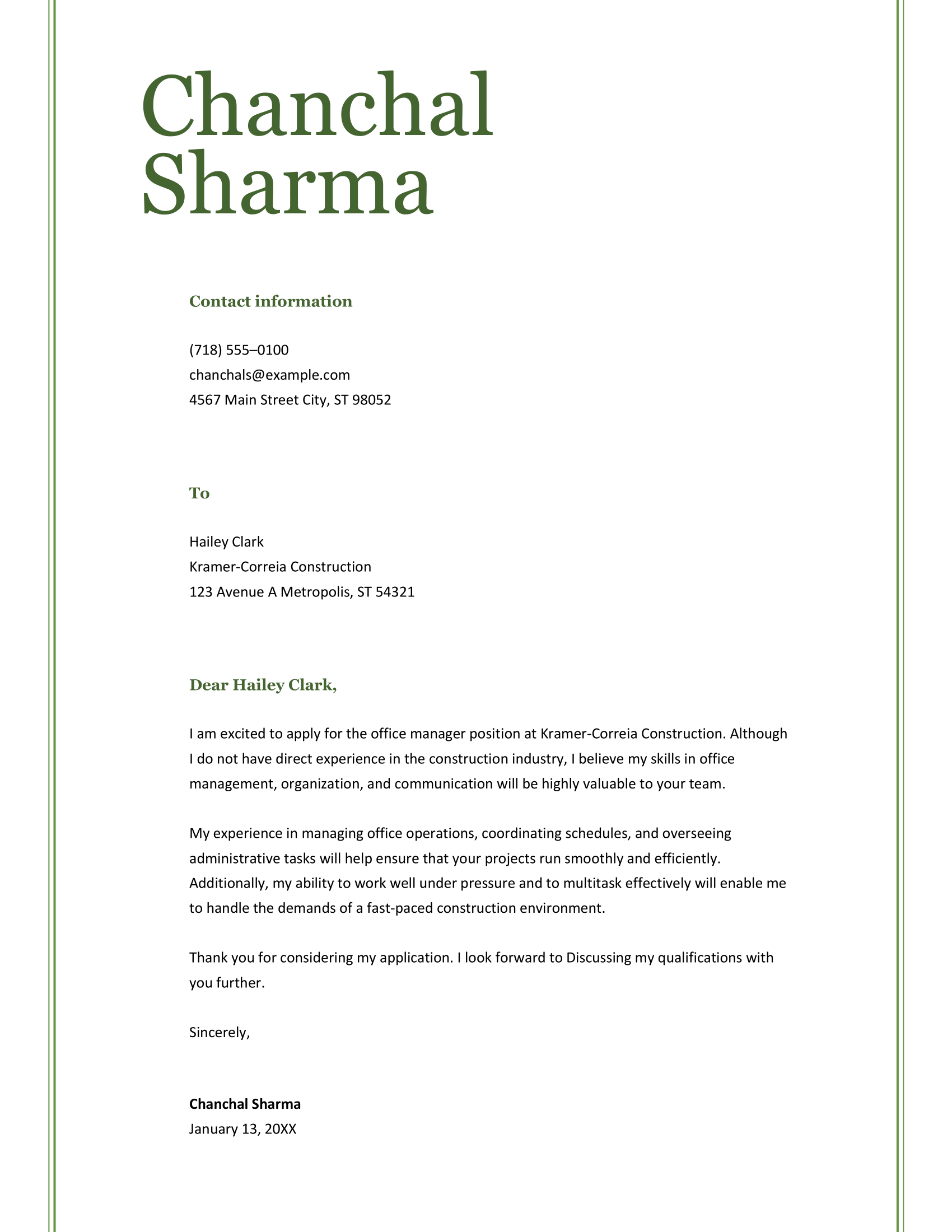
Pinstripes cover letter template
A creative yet polished option, this template works well across industries. For a cleaner layout, move your website and email to the top alongside your address, so recruiters can find them at a glance.
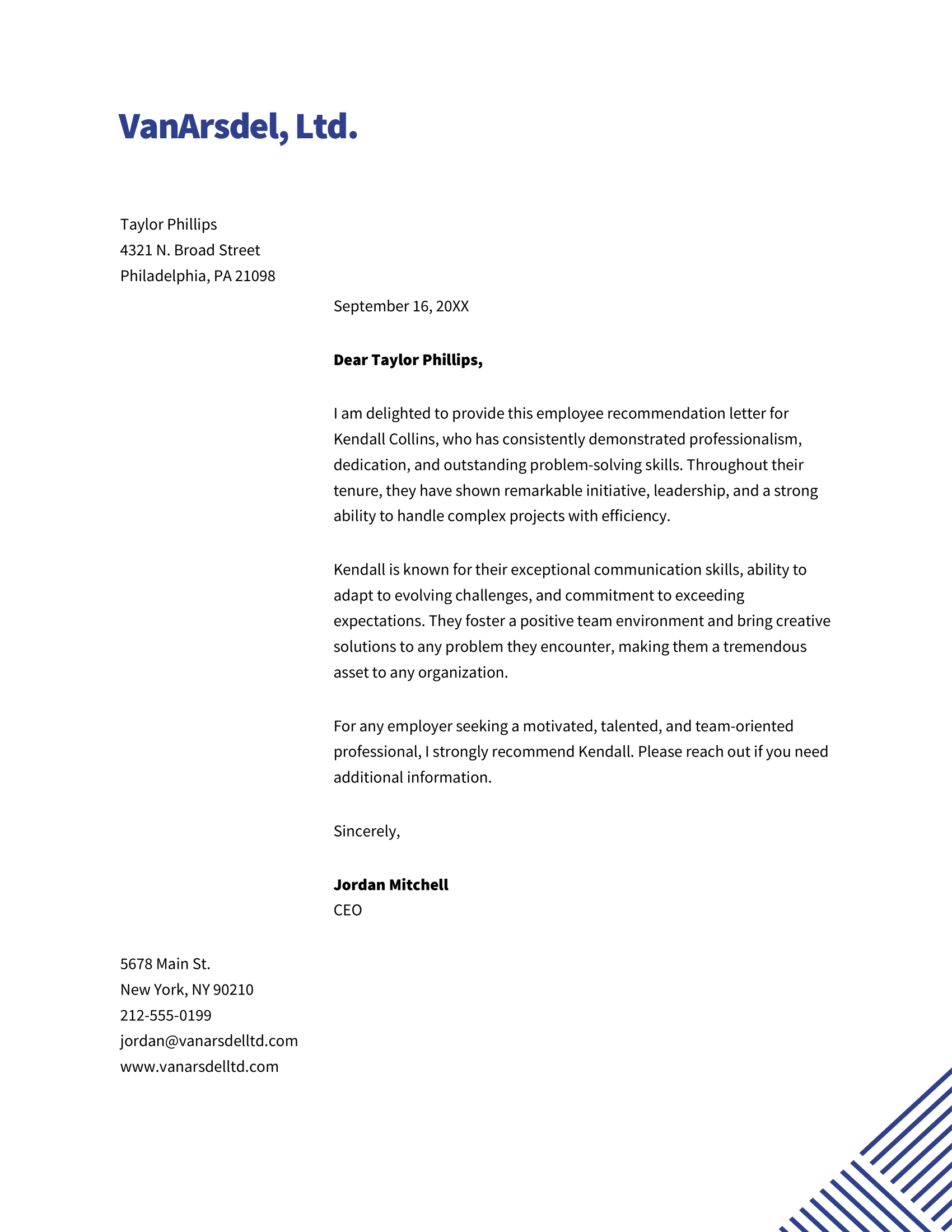
ATS classic cover letter template
This template is neat, well-organized, and very professional-looking. Remove the hiring manager’s details and use that extra space to include another reason why they should hire you.
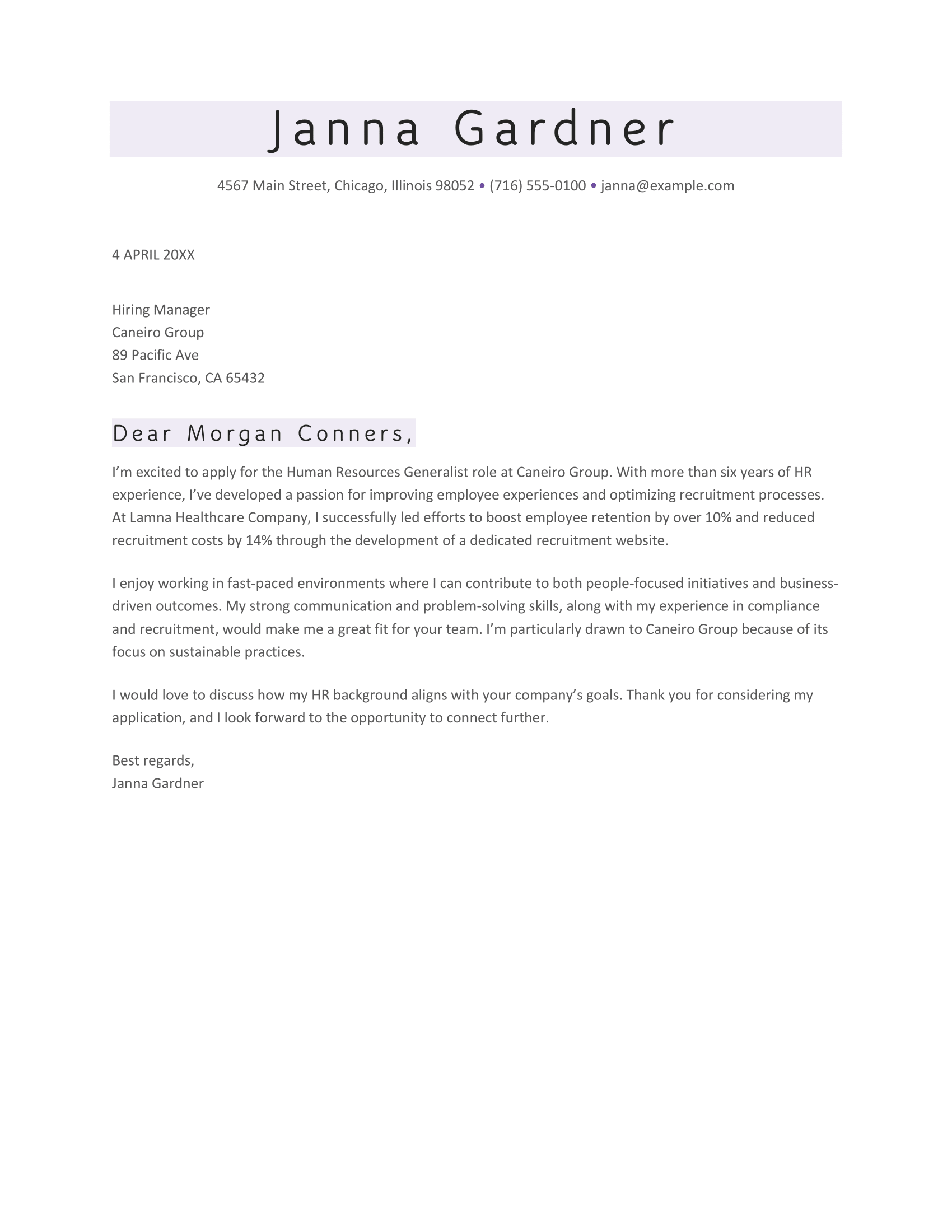
Manager cover letter template
With a subtle pop of color, this template strikes the right balance between standing out and staying professional. The date doesn’t need as much emphasis, so change it to black and reduce the size.

Now, let’s skim through some of Canva’s best cover letter templates:
Black and white cover letter template
This cover letter spotlights your name so it’s the first thing the hiring manager sees. It’s well-spaced and easy to follow, with helpful instructions for each section. One thing to adjust: don’t repeat your contact information in the closing paragraphs since it’s already at the top. Instead, just express your enthusiasm for discussing the role at a later time.
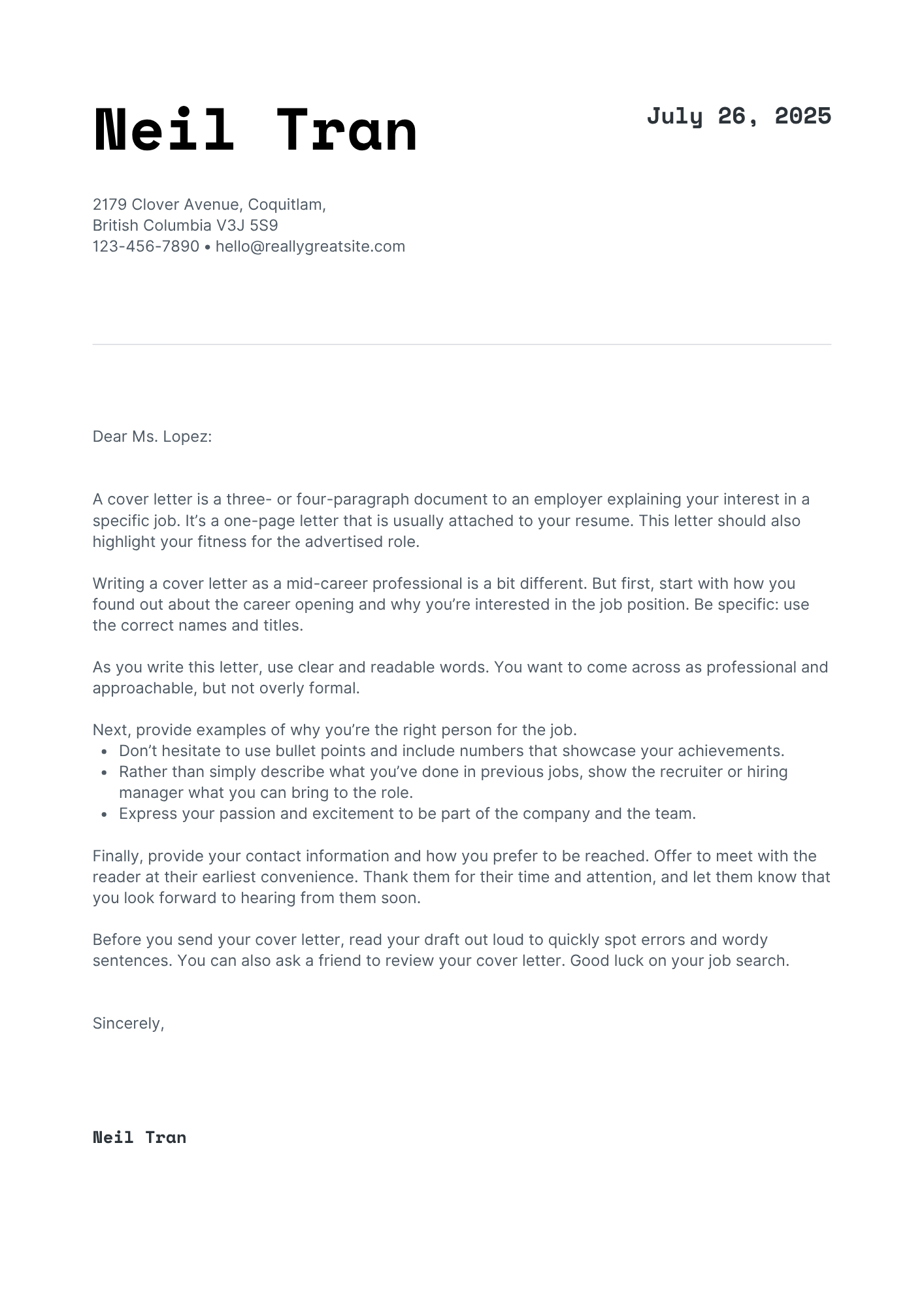
Simple cover letter template
This cover letter template features a clear header for your name and contact details and is ATS-friendly with its one-column layout. It’s text-heavy, so break up long paragraphs for easier readability.
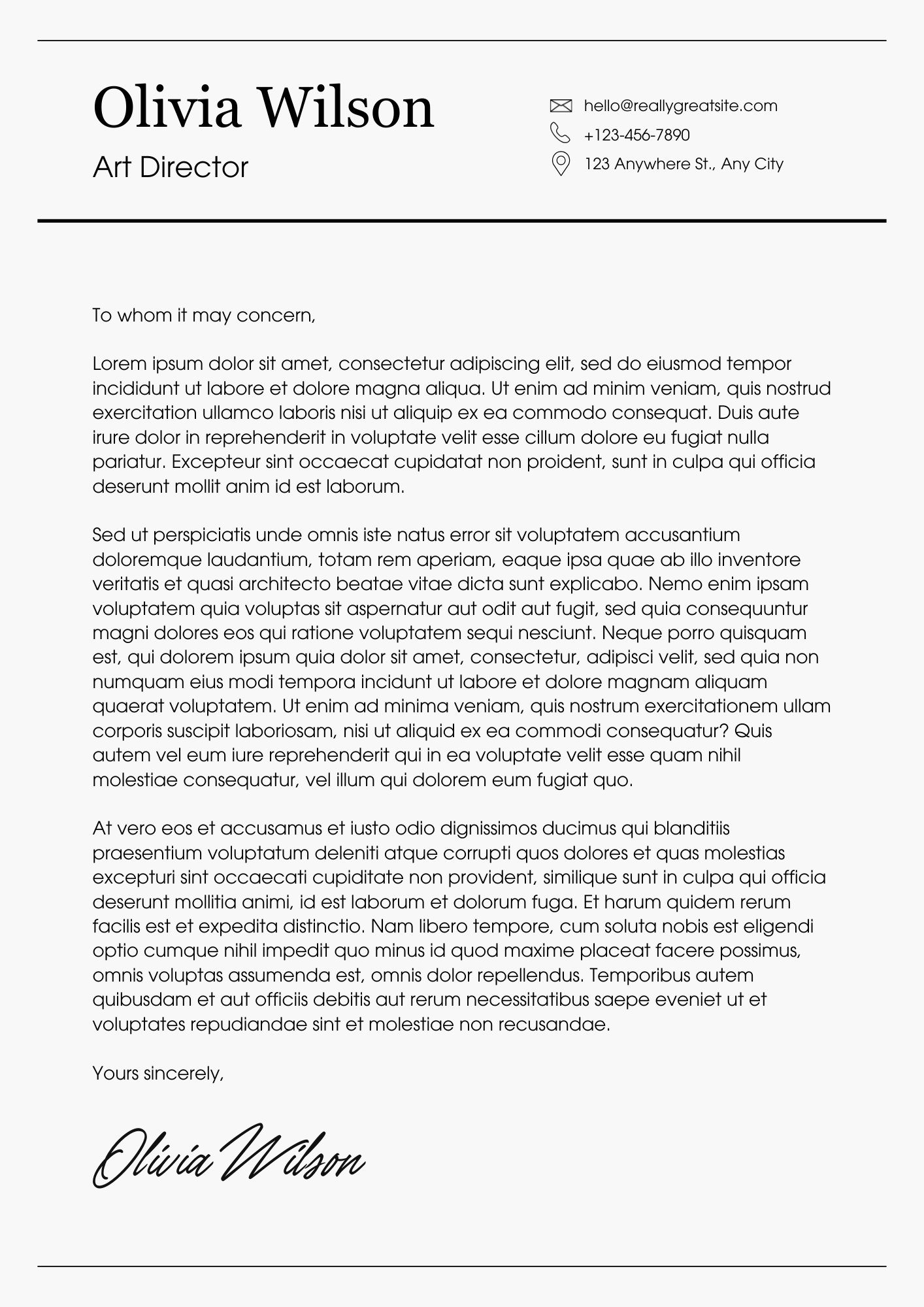
Minimalist cover letter template
With its clean design and professional header, this template focuses on key details. For digital applications, the hiring manager’s contact information is unnecessary and takes up valuable space — just include their full name in the greeting instead.

Red cover letter template
The subtle use of color in this template adds a unique touch without being overwhelming. Adjust the layout by removing the hiring manager’s address, moving the date above the greeting, and expanding the main body across the full width of the page.
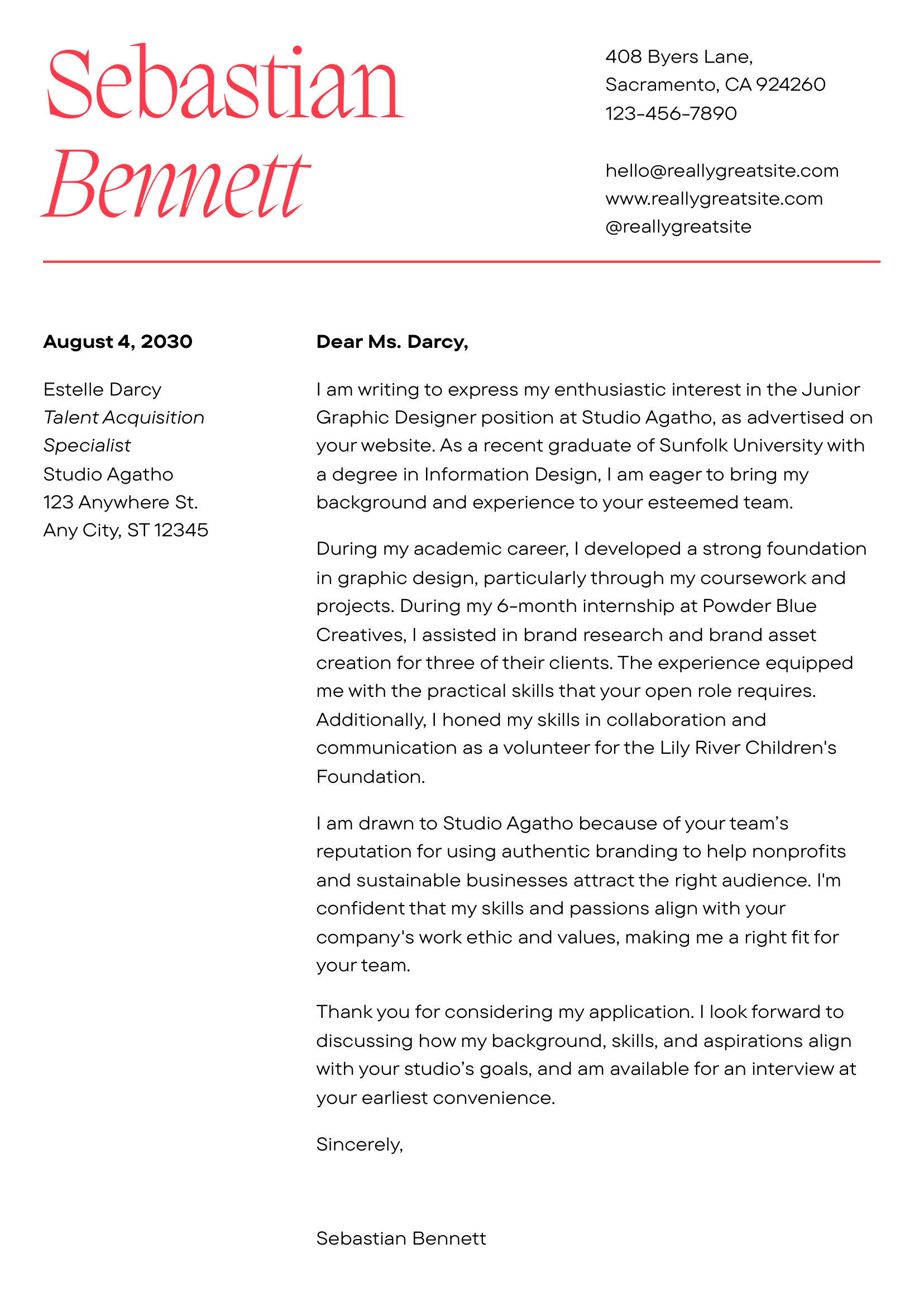
Basic cover letter template
This cover letter template condenses your contact details into one line, saving space for a well-organized layout. Use the extra space to format your cover letter with short, clear paragraphs: a greeting, an opening paragraph, one to three main paragraphs, and a professional closing.

Finally, here are some of the Google Docs best cover letter templates:
Spearmint cover letter template
A simple green line at the top gives this cover letter a fresh, modern touch. There’s plenty of space to outline all the reasons why you’re the perfect fit for the job.

Swiss cover letter template
The pop of orange in this cover letter can be adjusted to emphasize more important details, like your name instead of your job title. Keep your paragraphs short and easy to scan to avoid a wall of text.
-1.png)
Geometric cover letter template
With its bold graphics and modern color scheme, this cover letter is great for creative roles or companies that appreciate personality in an application. Since space is limited, it’s best for entry-level applications or those who can keep it concise.

Modern cover letter template
This sleek design is simple but stands out with its splash of color. The coding-style font makes it perfect for tech jobs. Swap ‘your company’ for your full name in bold at the top.
-1.png)
Summary
Here’s an overview of tips for writing the best cover letter:
- Your cover letter should show your personality and passion, not just a repetition of your resume.
- Keep the cover letter to one page with a simple layout. Use professional fonts like Arial or Verdana in 10–12 pt for the body text and make your name larger for emphasis.
- Instead of “To Whom It May Concern,” try to find the hiring manager’s name or use “Dear Hiring Manager.”
- Mention the job title and where you found it. Tie your excitement to the company and position.
- Start strong by showing enthusiasm and referencing the company’s mission or recent projects.
- Highlight key skills with concrete examples, ideally showing measurable impact (e.g. “cut data retrieval time by 30%”).
- Show you know the company’s culture or values and explain why you want to be part of it.
- If switching industries or lacking direct experience, explain how your transferable skills fit the role.
- End it by expressing your enthusiasm, highlighting how your skills match the company’s needs, thanking the hiring manager, and mentioning your eagerness to discuss further.
- Proofread for typos and awkward phrasing. It helps to have someone else review it too.
FAQ
What is the rule of 3 in a cover letter?
The “rule of 3” is a great way to keep your cover letter concise and impactful — highlight why you’re excited about the role, how your skills and experience align with the job, and why you’re a great fit for the company.
What are some mistakes to avoid in a cover letter?
Avoid being too generic and tailor your cover letter to the job and company. Don’t just repeat your resume — describe specific examples of your impact and why you’re perfect for this role. Start strong and always proofread for typos or grammar mistakes.
Can ChatGPT write my cover letter?
It can provide a solid starting point, suggest phrases, and help structure your thoughts, but you’ll want to personalize it to really show off your personality and passion for the role.
What is the best opening line for a cover letter?
The best opening should be engaging and to the point. Instead of something generic like “I’m applying for this job,” try something that shows your excitement for the role, like: “I was thrilled to see your opening for [Job Title] at [Company Name], and I’m eager to bring my [specific skill/experience] to your team.”
How long should it take to write a cover letter?
Writing a cover letter can take 30 minutes to a few hours, depending on your research and personalization. Take your time to highlight your skills and align them with the job.
If you need a quicker option, try our AI Cover Letter Builder.
Should I put my cover letter in the body of an email or attach it?
Either option works, but attaching your cover letter is usually best — it keeps the formatting intact and is easier to share. Just make sure your email subject is clear and professional.
How to show personality in a cover letter?
Express your excitement for the company’s work or mention a project or value that resonates with you. Remember to keep it professional — let your personality shine without being too casual.



